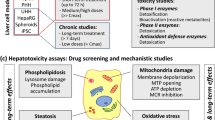Abstract
Potential induction of cytochrome P450 (CYP) by a new chemical entity (NCE) is a required assessment in small molecule drug discovery and development. CYP induction-mediated drug–drug interactions (DDI) can lead to decrease therapeutic efficacy, decreased exposure of concomitant medication, and an increase in activity or reactive metabolites leading to toxicity. Industrywide, CYP1A2, CYP2B6, and CYP3A are commonly assessed for induction via nuclear receptors aryl hydrocarbon (AhR), constitutive androstane (CAR), and pregnane X (PXR), respectively. Although cell lines are often used, because they lack native receptors, enzymes, uptake and efflux transporters, the current gold standard is cultured human hepatocytes. Cryopreserved hepatocytes are more readily available and offer the flexibility of donor selection and advanced experiment planning. This chapter describes the general methodologies used to determine CYP induction via mRNA expression and CYP enzyme activity using cryopreserved human hepatocytes.
Access this chapter
Tax calculation will be finalised at checkout
Purchases are for personal use only
Similar content being viewed by others
References
Guengerich FP (2008) Cytochrome 450 and chemical toxicology. Chem Res Toxicol 21:70–83
Fahmi OA, Ripp SL (2010) Evaluation of models for predicting drug-drug interactions due to induction. Expert Opin Drug Metab Toxicol 6(11):1399–1416
Chu V, Einolf HJ, Evers R, Kumar G, Moore D, Ripp S, Silva J, Sinha V, Sinz M, Skerjanec A (2009) In vitro and in vivo induction of cytochrome P450: a survey of the current practices and recommendations: a pharmaceutical research and manufacturers of America perspective. Drug Metab Dispos 37(7):1339–1354
Hewitt NJ, Lecluyse EL, Ferguson SS (2007) Induction of hepatic cytochrome P450 enzymes: method, mechanisms, recommendations, and in vitro–in vivo correlations. Xenobiotica 37(10–11):1196–1224
European Medicines Agency (EMA) (2012) Guideline on the investigation of drug interactions. https://www.ema.europa.eu/en/documents/scientific-guideline/guideline-investigation-drug-interactions
Hewitt NJ, Lechón MJG, Houston JB, Hallifax D, Brown HS, Maurel P, Kenna JG, Gustavsson L, Lohmann C, Skonberg C, Guillouzo A, Tuschl G, Li AP, LeCluyse E, Groothuis GMM, Hengstler JG (2007) Primary hepatocytes: Current understanding of the regulation of metabolic enzymes and transporter proteins, and pharmaceutical practice for the use of hepatocytes in metabolism, enzyme induction, transporter, clearance, and hepatotoxicity studies. Drug Metab Rev 39(1):159–234
Guillouzo A, Morel F, Langouët S, Maheo K, Rissel M (1997) Use of hepatocyte culture for the study of hepatotoxic compounds. J Hepatol 26(Suppl. 2):73–80
Alexandre E, Baze A, Parmentier C, Desbans C, Pekthong D, Gerin B, Wack C, Bachellier P, Heyd B, Weber JC, Richert L (2012) Plateable cryopreserved human hepatocytes for the assessment of cytochrome P450 inducibility: experimental condition-related variables affecting their response to inducers. Xenobiotica 42(10):968–979
Halladay JS, Wong S, Khojasteh SC, Grepper S (2012) An ‘all inclusive’ 96-well cytochrome P450 induction method: measuring enzyme activity, mRNA levels, protein levels, and cytotoxicity from one well using cryopreserved human hepatocytes. J Pharmacol Toxicol Methods 66(3):270–275
Nishimura M, Koeda A, Suzuki E, Shimizu T, Kawano Y, Nakayama M, Satoh T, Narimatsu S, Naito S (2006) Effects of prototypical drug-metabolizing enzyme inducers on mRNA expression of housekee** genes in primary cultures of human and rat hepatocytes. Biochem Biophys Res Commun 346:1033–1039
Pachot A, Blond JL, Mougin B, Miossec P (2004) Peptidylpropyl isomerase B (PPIB): a suitable reference gene for mRNA quantification in peripheral whole blood. J Biotechnol 114:121–124
Food and Drug Administration (FDA) Guidance (Draft) (2017) In vitro metabolism-and transporter-mediated drug-drug interaction studies guidance for industry. https://www.fda.gov/regulatory-information/search-fda-guidance-documents/vitro-metabolism-and-transporter-mediated-drug-drug-interaction-studies-guidance-industry
Kenny JR, Ramsden D, Buckley DB, Dallas S, Fung C, Mohutsky M, Einolf HJ, Chen L, Dekeyser JG, Fitzgerald M, Goosen TC, Siu YA, Walsky RL, Zhang G, Tweedie D, Hariparsad N (2018) Considerations from the IQ induction working group in response to drug-drug interaction guidances from regulatory agencies: focus on CYP3A4 mRNA in vitro response thresholds, variability, and clinical relevance. Drug Metab Dispos 46(9):1285–1303
Wolenski FS, **a CQ, Ma B, Han TH, Shyu WC, Balani SK (2018) CYP suppression in human hepatocytes by monomethyl auristatin E, the payload in brentuximab vedotin Adcetris® is associated with microtubule disruption. Eur J Drug Metab Pharmacokinet 43:347–354
Baumeister MA, Zhang N, Beas H, Brooks JR, Canchola A, Cosenza C, Kleshik F, Rampersad V, Surtihadi J, Battersby T (2012) A sensitive branched DNA HIV-1 signal amplification viral load assay with single day turnaround. PLoS One 7(3):e33295
Collins ML, Dailey PJ, Shen LP, Urdea MS, Wuestehube LJ, Kolgerb JA (1998) Branched DNA (bDNA) technology for direct quantification of nucleic acids: research and clinical applications. In: Ferré F (ed) Gene quantification. Advanced biomedical technologies. Birkhäuser, Boston, pp 205–223
Author information
Authors and Affiliations
Corresponding author
Editor information
Editors and Affiliations
Rights and permissions
Copyright information
© 2021 The Author(s), under exclusive license to Springer Science+Business Media, LLC, part of Springer Nature
About this protocol
Cite this protocol
Wong, S. (2021). Determination of In Vitro Cytochrome P450 Induction Potential Using Cryopreserved Human Hepatocytes. In: Yan, Z., Caldwell, G.W. (eds) Cytochrome P450. Methods in Pharmacology and Toxicology. Humana, New York, NY. https://doi.org/10.1007/978-1-0716-1542-3_12
Download citation
DOI: https://doi.org/10.1007/978-1-0716-1542-3_12
Published:
Publisher Name: Humana, New York, NY
Print ISBN: 978-1-0716-1541-6
Online ISBN: 978-1-0716-1542-3
eBook Packages: Springer Protocols




